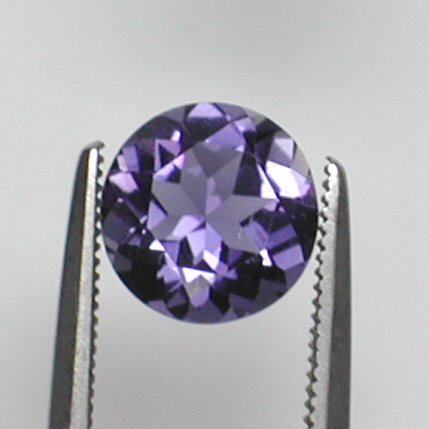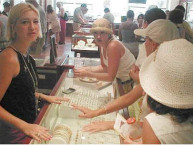Iolite:
A gemstone which has been gaining in popularity over the last few years is Iolite. This gemstone is a wonderful  color, in ranges of Violet, bluish violet, violet blue, and blue. It can be transparent to translucent. Under magnification there may be inclusions but in general look for stones which are eye-clean. Inclusions of hematite cause reddish aventurescence (bloodshot Iolite); other inclusions cause cat’s eyes and stars, although these are quite weak. The differences in the color hues can be subtle and usually does not affect the over all value of the stone. The Iolite that is in highest demand is deep, bright, vivid blue. Color may be very strong blue in one direction, changing to pale grayish-blue to nearly colorless or yellowish as the stone is turned. While Sapphire and Tanzanite can be very expensive, especially in the larger sizes, Iolite supplies are very plentiful and so is relatively inexpensive. Iolite over 10 carats is rare though and prices will reflect that.
color, in ranges of Violet, bluish violet, violet blue, and blue. It can be transparent to translucent. Under magnification there may be inclusions but in general look for stones which are eye-clean. Inclusions of hematite cause reddish aventurescence (bloodshot Iolite); other inclusions cause cat’s eyes and stars, although these are quite weak. The differences in the color hues can be subtle and usually does not affect the over all value of the stone. The Iolite that is in highest demand is deep, bright, vivid blue. Color may be very strong blue in one direction, changing to pale grayish-blue to nearly colorless or yellowish as the stone is turned. While Sapphire and Tanzanite can be very expensive, especially in the larger sizes, Iolite supplies are very plentiful and so is relatively inexpensive. Iolite over 10 carats is rare though and prices will reflect that.
 What makes this an interesting stone is its historical importance. The Vikings relied on this stone to venture far out to sea. Remember that back in the times of the Vikings there were no instruments to assist in navigation.
What makes this an interesting stone is its historical importance. The Vikings relied on this stone to venture far out to sea. Remember that back in the times of the Vikings there were no instruments to assist in navigation.
They relied on the position of the sun, the stars etc. They took thin slices of iolite to use as a polarizing lens, they could hold it up and determine the exact position of the sun. With this bit of crude technology they were one of the first to voyage across the oceans to the new world and safely back. Historians feel they mined this iolite in Norway and Greenland.
The name iolite comes from the Greek “ios”, which means violet.
Iolite exhibits a characteristic known as “Pleochroism” which means exhibiting different colors, especially three different colors, when viewed along different axis. Iolite is sometimes known as Dichroite to some gemologists. This characteristic, although fascinating to look at, presents a definite challenge to cutters. If the rough is not cut at the angle the iolite wishes to be cut, the stone will not exhibit the rich color that it possesses.
Another fascinating characteristic of Pleochroism is the contrast between the stone’s face up blue or violet color and its colorless appearance through the side. This is why Iolite is sometimes referred to as “Water Sapphire”
For durability it is rated as “fair”. I would suggest this stone be utilized in ear-rings or in a pendant to avoid the knocks of everyday life. It has a hardness rating of 7 – 7 1/2.
Care of your Iolite: The safest way to clean your Iolite Jewelry is with warm soapy water. Avoid the ultrasonic and steam cleaner.
Today Iolite is mined in India, Sri Lanka, Mozambique, Zimbabwe, and Brazil.



